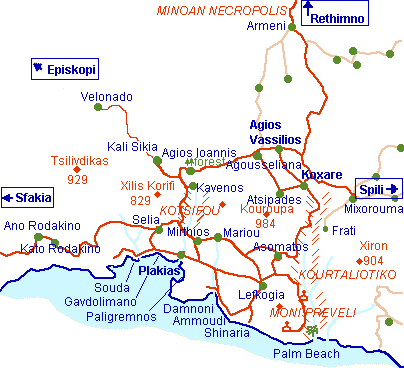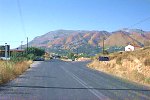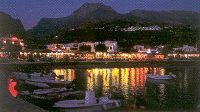
Access
Regular bus transportation is available from Rethimnon to Plakias. The road is fairly good and the countryside of Rethimnon is of exceptional beauty.
The village can be accessed also from Iraklion through the Messara valley - Spili.
From Hania there is a very interesting itinerary passing from Vrisses, plateau of Askifou, Sfakia, Fragokastello, Rodakino, Plakias.
TOP
From Rethymno to Plakias
Starting from Rethymno we follow the signposts to "SPILI" . Around 8.5 km from Rethimno a signpost points to the Archaeological site of the "Late Minoan Cemetery" which is located about 20 meters to the right.
There is a large parking area and the small stone built guard's hut at the entrance of the site.
Both the site that is located at an oak covered hill, as well as the vaulted Minoan tombs will impress you.
Visiting hours : 8:30 - 15:00 (Monday closed)
TOP
One and a half km after the Archaeological site stands the village of Armenoi, where you can find a card phone, a grocer's shop, cafes etc.

The crossroads after Armenoi |
Ten kilometers after Armenoi is a crossroads where you will find a gas station and two taverns, open from early in the morning to late in the night. At this point you have two options, for the course to be followed. Both lead to Plakias with a small difference in their length but if your final destination is Fragokastelo and Sfakia then you have to take the road to the right.
After two km is the beautiful village of Agios Vassilios which is built among vine and olive groves and gave its name to the hole county.
During the the 2nd Byzantine period it was the seat of the district of "KATO SYVRITOS" and during the Venetian occupation the seat of the "CASTELLANIA BASEIO".
A walk through the narrow paved streets of the village with the old stone built houses, will give you the opportunity to meet the hospitable people, learn its history, visit the beautiful church with the important belfry, the war memorial , and enjoy a raki or a Greek coffee at the villages square, under the perennial plane trees.
There is also a small cave with stalagmites in the village, but the access is quite difficult, as the entrance, which is from a house's yard, is extremely narrow. A torch is essential if one wants to explore the cave.
Leaving the village of Agios Vassilios we continue our journey passing from the small village Agousseliana, and after a 2km drive among trees like cypress, plane trees and arbutus we reach Agios Ioannis. A stop here is also worthwhile.
TOP
Built at 460 m a.s.l. Agios Ioannis is mentioned since 1577 from Fr Barozzi to be part of the county of Agios Vassilios.
In 1770 the Turks burned the church of "Agios Ioannis" which was rebuilt and dedicated this time to "Agios Georgios". A significant battle took place here during the revolution against the Turks, when Vourdoumbas, Kourmoulis and other revolutionaries stopped the enemy's advance.
Kanevos is located just before the entrance of the "KOTSIFOU" gorge at 450 m a.s.l. There are a couple of good taverns with rooms for rent, operating all year around, for those who want to make Kanevos their base for excursions to the broader area. The name "Kanevos" is considered to be of Venetian origin (caneva= wineshop) as in the past there were some renowned inns here.
TOP
Just before the gorge is the road to the village "Kali Sikia" located a few kilometers to the west. The raod has on its left the gorgeous summit of "Tsilivdikas" and the impressive "Kaliskiano" gorge.
Kali Sikia, was mentioned by Fr Barozzi at his 1577 census to be comprised of two separate settlements, Pano and Kato Kali Sikia. Emm. Lamprinakis, a teacher from Rethimno, writes that in 1830 Mohamad Ali had a coal mine at Kali Sikia.
From Kali Sikia there is an up-hill dirt road through an impressive landscape which leads to the village Velonado. Experienced walkers or bicyclists will enjoy this route, which is however recommended to start from Velonado.
Leaving behind us the villages of the of Agios Ioannis, we continue to the south through the "Kotsifou" gorge. The road stretches along the high vertical walls and after a few kilometers we have in front of us the imposing view of the southern coastline. Now the road splits in two: to the righ towards the village Selia and then Rodakino, Fragokastelo, Sfakia. The road to the left goes to the traditional village of Mirthios
Mirthios is a small village with 224 permanent residents built on the southern slope of the mountain "Kouroupa" (984m), 36 km from the city of Rethimnon.
It is the birthplace of the linguist George Hatzidakis and his brother John both wellknown university professors.
The name Mirthios (or Mirtos) is believed to come from the plant "mirsini".
Mirthios is an old (first mentioned at the Fr Barozzi's census in 1577) traditional village with picturesque paved narrow streets and stairways, and a breathtaking view of the bay of Plakias and the surrounding mountains.
One of the places worth to see is the old small church of "Metamorfossis tou Sotiros", with remarkable well preserved frescoes.
The visitor can enjoy the cretan specialties at the small taverns of the village. Quite few apartments and rooms for rent are available for those who want to spend the night at Mirthios or make it their starting point for exploring the surrounding area.
From Mirthios one road goes to the beautiful village of Mariou and another to Plakias.
TOP
Plakias is a coastal village,
40 km south from Rethimno, with 237 permanent residents, built at the cove of the bay of the same name on a wonderful sandy beach, 1300 m long, between the capes Stavros
and Kako Mouri, that is ideal
for swimming and sea sports.

Plakias at night |
The first mention of Plakias was in the census of 1961 when only 6 fishermen were its permanent inhabitants. The natural beauty of the place helped Plakias to become a renowned tourist resort now providing all the facilities that a visitor could wish.
Large hotels, youth hostel, small traditional style apartments, camping site, taverns, restaurants, bars, everything to make the visitors' stay comfortable and unforgetable. There are many small secluded beaches for the naturalism lovers as well as some organized ones providing quite few facilities such as sun chairs, umbrellas, sea sports etc.
TOP
Starting from Plakias to the east we can access the beach of Paligremnos, at the eastern side of the bay of Plakias, or continue to the neighboring cove of Damnoni.
Damnoni is a beach within a few kilometers to the east of Plakias. It used to be one of the cleanest and most attractive beaches for the lovers of camping and naturalism during the 70's.
Nowadays that large hotels are built there, Damnoni became a popular tourist resort getting fairly crowded especially during the high season.
At the beach now there are umbrellas, sunbeds, and sea sports while
a couple of taverns located on the beach offer good food and fresh fish.
There are however some smaller beaches, not far from Damnoni accessible by the sea or even by car (dirt road).
A dirt road only a few kilometers long, starts from Damnoni and ends at the small cove of Ammoudi where there is a beach ideal for camping with quite few trees, running water a tavern and a small hotel. The beach is also accessible from the village of Lefkogia, via an asphalt road at a point of which an intersection leads to the wonderful beach of Shinaria located in a small cove east from Ammoudi. We will find there a tavern with good food and service.
A couple of really nice beaches are located west of Plakias, the first being this of Gavdolimano. Continueing to the west we will find the wonderful beach of Souda, with palm trees, fine sand, clear water and quite few facilities such as small hotels and lovely taverns.
TOP
Taking the road back to Mirthios, five km from Plakias along a route with a panoramic view to the coast and the surrounding mountains, we reach Mariou, a picturesque village built on the southern slope of Kouroupa. At the entrance of the village we meet the church of "Ipapanti" a place which invites you to make a stop and admire the view and the old church's architectural style.
Mariou is mentioned in the 1577 census of Fr. Barozzi being thereafter always inhabited. The name comes probably from a noblewoman named "MARIA" who used to live here.
TOP
Leaving Mariou we take the road to Asomatos, a 3.5km drive and then turning to the right we take the road which, passes through the impressive Kourtaliotiko gorge and reaches after 6km the monastery of Kato Preveli.
Kourtaliotiko Gorge is formed by the steep sides of the mountains Kouroupa and Xiron. Its imposing entrance is near the village Koxare a place named "profarago". Iside the gorge flows the river megapotamos or kourtaliotis or massalias, which collects the water from the valley of Agios Vassilios and Spili. The gorge ends at the sea creating a small lake surrounded by palm trees. Not far from there is the famous monastery of Preveli.
The strong winds make the steep rocky walls to whistle, and sweep small stones that tumble and crackle. This noise gave the name "kourtaliotiko" (=crackling) to the gorge.
A little before the exit of the gorge there is a small waterfall, about 40m high. The water comes out of five points and flows all year around.
According to a legend those five springs were made from the imprint of the fingers of Saint Nicholas, an ascetic who was born in the nearby village Frati and used to live there years ago, on arock. This miracle happened because the ascetic had no water an was about to leave the place. In memorial to this Saint, which is celebrated at September 1st, the local people called the spring "evlogia kiriou" (Lord's blessing) and built a small chapel a little further from that spring.
S.Spanakis
KRITI v.B' |
TOP
The monastery of Preveli
It stands 37 km south of Rethimnon, in an imposing landscape which is mentioned at the mid-19th century diary of Sir John Spratt (admiral of the British Royal Navy), as "one of the happiest places to withdraw from trials and responsibilities of life".
There are lots of legends concerning the foundation of the monastery, which is believed that started during the Venetian occupation of the island. A number of its monks activities made the monastery one of the richest of western Crete and due to its isolated position it played important role in Cretan revolts against the occupying forces.

Kato Monastiri |
The monastery consists of two separated blocks, "Pisso Monastiri" and "KATO MONASTIRI". Arriving from Rethimno we first meet "Kato Monastiri" with the church of "Agios Ioannis o Prodromos" today being isolated and after two kilometers to the south we meet Pisso Monastiri, most renowned to the visitors, dedicated to "Agios Ioannis o Theologos".
The exisiting buildings are not the original ones, but what is left from the Turks distructions and the later modifications and extensions.
There are many valuable relics kept in the monastery museum such as:
- The icon of Christ "king of the kings" work of the painter Michail Prevelis (1750),
- The icon of "Agios Ioannis o Theologos" (13th century)
- The miraculous Crucifix (18th century)
- The splendid iconostasis and many others.
More infrormation about the Monastery can be found at : www.preveli.org
The Holy Monastery of Preveli, to mark the occasion of the 60th anniversary of the Battle of Crete, will undertake to erect privately and under its supervision, an international memorial dedicated to peace and remembrance.
Those who wish to support this project will find information at: http://www.preveli.org/files/memorial/en40.htm
TOP
Both Palm Beach (Limni) as well as the monastery of Preveli can be accessed from the village Lefkogia, located a little to the north of the beaches of Ammoudi and Shinaria. Lefkogia is a small village with 239 inhabitants. Its name comes from the white (=lefko) and land (=gea) and has to do of course with the color of the land of the area.
From Lefkogia we take the road to the right which leads to Gianniou and from here a dirt road will take us to the Pisso Monastiri of Preveli.
From the monastery there are some walking paths leading to the Palm beach from the west, but an easier route is to go back to Kato Monastiri and after 500m take the road to the east which after about 2km reaches at parking area where a couple of taverns stand. Ten minutes walk away is the Palm Beach.
The Palm Beach( LIMNI)

Limni |
The gorge that forms the river "megapotamos" ends at the Libyan Sea creating a small lake at its delta.
This lake surrounded by palm trees and rich vegetation is one of the most attractive places in Crete and once used to be an ideal place for camping and naturalism lovers.
The sea is clean with a dazzling range of green and blue colors.
The place is accessible only by foot or by boat. Many organized cruises start from Plakias or Agia Galini to bring visitors at LIMNI which can be fairly crowded during the high season. Only a few facilities are provided to the visitors.
TOP
Taking the up-hill road through the Kourtaliotiko gorge (at least 2.5km of this road is inside the gorge) we reach the village Koxare.
Koxare and the neighboring village of Atsipades together with the settlements of Bale, Tsikalario and Katsogrida were parts of the former commuity of Koxare.
The area is covered with olive trees, vine yards and plane trees while the megapotamos river, which flows through it, forms a really wonderful lanscape. There are some significant monuments of the Cretan culture and history such as the stone built bridge by the megapotamos, the ruined Venetian fortress, the chapel of Agios Georgios as well as a folklore museum.
The visitor will find some good taverns with local specilties and a pension for accommodation. There is also a gas station.
Tourist Facilities
The area provides
all the facilities for tourists.
Hotels, apartments, camping, and of course lots of bars, restaurants and taverns serving fresh fish and specialties from the local and international cuisine.
There is also a dock for small boats. Many cruises to the broader area such as Sfakia to the west or Matala, Agia Galini and Preveli to the east are scheduled in the summer time.
|
|
Best Car Rental in Crete
Search our reservation system for vehicles and dates and receive an instant online quote. Alternatively send us your request for a customized car hire arrangement
| CityCar Rent A Car
Low cost - Safe cars - the cheapest in town, Free airport, port, hotel delivery all over Crete
|
Horafakia Car Rental
A local company with very good knowledge of the island and the travelers needs.
| Die Zwei Brueder Pension, Matala
The name for Quality. Plenty of sun, good food, very welcoming people and we at DIE ZWEI BRUDER ...
|
|
|
|